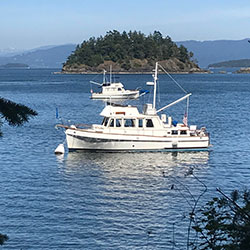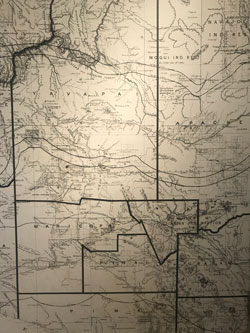The Reading Corner Newsletter
September 2020
 Hello readers! We’re inching into fall, although it’s still glorious weather here in the Pacific Northwest. We never know when the curtain will come down and usher in six months of rain, so we’re busy outside gardening and walking and boating. Thinking of all of you readers affected by the wildfires and smoke in Washington, Oregon, California, and Arizona. Please take care.
Hello readers! We’re inching into fall, although it’s still glorious weather here in the Pacific Northwest. We never know when the curtain will come down and usher in six months of rain, so we’re busy outside gardening and walking and boating. Thinking of all of you readers affected by the wildfires and smoke in Washington, Oregon, California, and Arizona. Please take care.
Michael and I have two more trips out on Polaris scheduled for September, with fingers crossed that the weather holds.
Publishing Update:
 Thanks to the Outliers (Anacortes, WA) and Seven Sisters (Sedro Woolley/Seattle, WA) book clubs for lovely, socially distanced events this past month to discuss Ada Weeks’ journey in Answer Creek. I’ve also started a robust Zoom book club schedule (get on my calendar by contacting me now if you want a slot for 2021; 2020 is now full). Looking forward to being a part of several upcoming panels, radio interviews, and virtual book talks. Check my Media webpage for details.
Thanks to the Outliers (Anacortes, WA) and Seven Sisters (Sedro Woolley/Seattle, WA) book clubs for lovely, socially distanced events this past month to discuss Ada Weeks’ journey in Answer Creek. I’ve also started a robust Zoom book club schedule (get on my calendar by contacting me now if you want a slot for 2021; 2020 is now full). Looking forward to being a part of several upcoming panels, radio interviews, and virtual book talks. Check my Media webpage for details.
 Words keep multiplying at my desk, nouns and verbs and adjectives mixing like chemistry. I’m probably a third of the way through the new manuscript, all the while furiously reading Arizona history and transposing notes in—yes—more black and white composition notebooks.
Words keep multiplying at my desk, nouns and verbs and adjectives mixing like chemistry. I’m probably a third of the way through the new manuscript, all the while furiously reading Arizona history and transposing notes in—yes—more black and white composition notebooks.
I especially enjoyed Vanished Arizona by Martha Summerhayes, the memoir of a late 19th century Army wife who followed her husband to rural Arizona, first in 1874. And when I say “rural” it’s not rural how you or I define it today. We’re talking about nothing for hundreds of miles between military forts, “nothing but dust and cactus and scorpions and rattlesnakes in these parts,” as my protagonist says. And my protagonist has a name now: Ruby (and an image as I picture her, painted by Tucson artist Allen Polk). The painting is titled “Girl with the Red Gloves” and is owned by Lynn and Court Hall of Tucson.
ARIZONA HISTORY FACTOID:
This factoid is an example of how one can go down a proverbial “rabbit hole” while researching. You ask the question, “How many military installations were in Arizona Territory in the 19th century?” Three days later, you’re still deep into 19th century military history and getting deeper by the hour!
The answer is there were 12 military forts in Arizona Territory before 1900 (listed here with present-day city, if not apparent). Some forts changed names over their tenures, also indicated below. Only a handful of forts have been preserved (marked with an asterisk):
*Fort Bowie
Fort Buchanan (Sonoita)
Fort Colorado/Mojave
Fort Defiance (Window Rock)
Fort Goodwin (San Carlos Reservation)
Fort Grant/Breckinridge (Stafford)
*Fort Huachuca (Sierra Vista)
*Fort Lowell (Tucson)
Fort Meeks/Lee’s Ferry
Fort Ord/Mogollon/Thomas/Apache (White Mountain Reservation)
Fort Verde/McDowell (Bullhead City)
*Fort Whipple (Prescott)
Top Reads of All Time:
Recently a reader asked me for my top three reads of all time. Talk about a challenge! It’s hard to winnow it down after a lifetime of reading, but here is my answer:
The Little Prince, Antoine de Saint-Exupéry
The Waves, Virginia Woolf
Cold Mountain, Charles Frazier

There’s Always a Prize Question:
Congratulations to Michelle Ferrer, chosen randomly as the winner of last month’s question asking readers to suggest names for Arizona mines where my new protagonist has a large stake.
Here are a few of your suggestions:
Diablo Fiero
El Dorado
Esperanza
Silverado
Buena Vista
Golden Vein
 This month you’ve got your chance to name Ruby’s dog, a male mutt her son rescues after it’s badly injured. Answer at contact@ashleysweeneyauthor.com for a chance to win a $10 Starbucks gift card (chosen randomly on the last day of the month).
This month you’ve got your chance to name Ruby’s dog, a male mutt her son rescues after it’s badly injured. Answer at contact@ashleysweeneyauthor.com for a chance to win a $10 Starbucks gift card (chosen randomly on the last day of the month).
Thanks for your emails. Anytime you’ve got a question or comment, don’t hesitate to contact me!
Until next month, Happy Reading!
Ashley